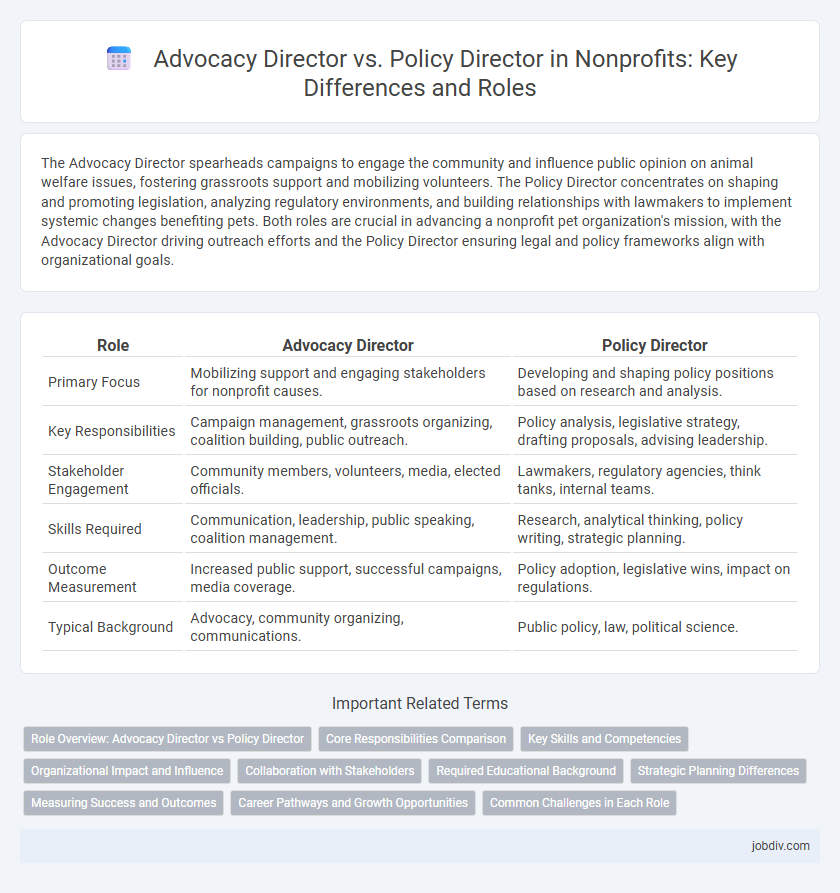The Advocacy Director spearheads campaigns to engage the community and influence public opinion on animal welfare issues, fostering grassroots support and mobilizing volunteers. The Policy Director concentrates on shaping and promoting legislation, analyzing regulatory environments, and building relationships with lawmakers to implement systemic changes benefiting pets. Both roles are crucial in advancing a nonprofit pet organization's mission, with the Advocacy Director driving outreach efforts and the Policy Director ensuring legal and policy frameworks align with organizational goals.
Table of Comparison
| Role | Advocacy Director | Policy Director |
|---|---|---|
| Primary Focus | Mobilizing support and engaging stakeholders for nonprofit causes. | Developing and shaping policy positions based on research and analysis. |
| Key Responsibilities | Campaign management, grassroots organizing, coalition building, public outreach. | Policy analysis, legislative strategy, drafting proposals, advising leadership. |
| Stakeholder Engagement | Community members, volunteers, media, elected officials. | Lawmakers, regulatory agencies, think tanks, internal teams. |
| Skills Required | Communication, leadership, public speaking, coalition management. | Research, analytical thinking, policy writing, strategic planning. |
| Outcome Measurement | Increased public support, successful campaigns, media coverage. | Policy adoption, legislative wins, impact on regulations. |
| Typical Background | Advocacy, community organizing, communications. | Public policy, law, political science. |
Role Overview: Advocacy Director vs Policy Director
The Advocacy Director leads campaigns to mobilize public support and influence legislative outcomes, focusing on community engagement and grassroots organizing. The Policy Director develops, analyzes, and advises on strategic policy initiatives, shaping the organization's stance on legislative and regulatory issues. Both roles are critical in advancing nonprofit missions but prioritize different strategies: advocacy targets external action and public momentum, while policy centers on internal expertise and legislative influence.
Core Responsibilities Comparison
An Advocacy Director leads campaigns to influence public opinion and mobilize supporters, focusing on grassroots engagement and external communications. In contrast, a Policy Director develops and analyzes policy proposals, advises organizational strategy, and fosters relationships with lawmakers to shape legislation. Both roles collaborate to advance the nonprofit's mission, but the Advocacy Director emphasizes public action while the Policy Director prioritizes detailed policy expertise and legislative impact.
Key Skills and Competencies
Advocacy Directors excel in communication, coalition-building, and grassroots mobilization to influence public opinion and engage stakeholders effectively. Policy Directors possess expertise in legislative analysis, regulatory knowledge, and strategic policy development to guide organizational positioning and compliance. Both roles require leadership, strategic thinking, and deep understanding of the nonprofit's mission to drive impact and advance advocacy goals.
Organizational Impact and Influence
An Advocacy Director primarily mobilizes grassroots support and builds coalitions to directly influence public opinion and legislative outcomes, enhancing organizational visibility and community engagement. A Policy Director concentrates on research, analysis, and strategic development of policy positions, crafting recommendations that shape institutional agendas and long-term legislative priorities. Both roles drive organizational impact by aligning advocacy efforts with policy objectives, ensuring coherent influence on social change and governmental decision-making.
Collaboration with Stakeholders
The Advocacy Director leads efforts to build strong coalitions with diverse stakeholders, including community members, government officials, and partner organizations, to drive public support and mobilize grassroots action. In contrast, the Policy Director engages primarily with legislative bodies, regulatory agencies, and policy experts to influence and develop specific policy proposals. Both roles require effective collaboration and communication to align advocacy strategies with policy goals, ensuring cohesive and impactful nonprofit initiatives.
Required Educational Background
Advocacy Directors typically require a bachelor's degree in social sciences, communication, or related fields, with many organizations preferring candidates with a master's in public administration or nonprofit management. Policy Directors often need advanced degrees such as a master's or doctorate in public policy, political science, or law to effectively analyze and influence policy development. Both roles emphasize strong analytical and leadership skills, but the Policy Director position demands deeper expertise in legislative processes and regulatory frameworks.
Strategic Planning Differences
Advocacy Directors concentrate on mobilizing community engagement and grassroots campaigns to influence public opinion and legislative outcomes, emphasizing tactical outreach and coalition-building. Policy Directors prioritize the development and analysis of policy proposals, focusing on research, regulatory frameworks, and long-term legislative strategy. Their strategic planning differs as Advocacy Directors align efforts with immediate public and stakeholder actions, while Policy Directors center on in-depth policy formulation and institutional change.
Measuring Success and Outcomes
The Advocacy Director measures success through community engagement metrics, campaign impact, and stakeholder mobilization, focusing on tangible changes in public awareness and support. The Policy Director evaluates outcomes by tracking legislative advancements, policy adoption rates, and the implementation effectiveness of specific regulations. Both roles require data-driven assessments but prioritize different stages of influence: advocacy emphasizes public momentum, while policy centers on formal institutional change.
Career Pathways and Growth Opportunities
An Advocacy Director typically advances by gaining experience in grassroots mobilization, stakeholder engagement, and public relations, building a strong network to influence policy decisions. In contrast, a Policy Director focuses on developing expertise in legislative analysis, regulatory frameworks, and strategic policy formulation, often progressing through government affairs or research roles. Both pathways offer growth opportunities toward executive leadership in nonprofit organizations, with Advocacy Directors leaning toward community-facing roles and Policy Directors excelling in technical policy development.
Common Challenges in Each Role
Advocacy Directors often face challenges in mobilizing grassroots support and effectively communicating stakeholder concerns to policymakers while balancing organizational resources. Policy Directors grapple with interpreting complex legislation, influencing policy development, and ensuring alignment between advocacy goals and legal frameworks. Both roles require strategic collaboration across teams and adaptability to shifting political landscapes to advance the nonprofit's mission.
Advocacy Director vs Policy Director Infographic

 jobdiv.com
jobdiv.com